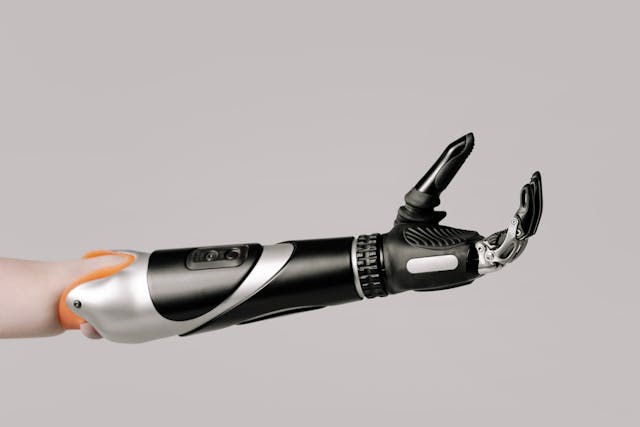
How can a person control a bionic limb? There are generally four ways a person can control a bionic limb. They can use a special harness that can open or close hooks. They can have sensors that read electrical signals through the skin. They can attach directly to the nerves. They can have sensors that read the electrical signals directly from the muscles.
Losing a limb is not an uncommon occurrence. It is estimated that over one million people lose a limb or are born without a limb every year. The causes for this limb loss vary. America has about 500,000 limb amputations a year and 60% of those are due to diabetes. Diabetes can cause nerve damage and circulation problems, leading to the death of limbs, which then have to be amputated. Humans can obviously still function without a limb, and we can learn to cope, but everything is just much easier with all our limbs. In order to compensate, medical science has always tried to come up with solutions. Early prosthetics were wooden legs or arms with a hook. They couldn’t move, but people could balance or pick stuff up. Modern science has come a fairly long way since then. Let’s look at four different methods of making prosthetics that can be controlled.
The simplest method is to use a harness that the wearer can control by moving other muscles. Some prosthetic arms go over the amputated limb and they have a cable that goes up the arm, across the shoulder, and is fastened to a harness on the other side. When you shrug your shoulder, it tightens the cable, and the hook will open. To close the hook, you just have to relax your shoulder. You can tell if the hook is open or closed by the tension across the shoulder. They are very basic, but they are simple.
A second way is to read the signals that the nerves are transmitting. When we want to move our hand, our brain sends signals that travel down our nerves to make the relevant muscles contract or relax. Even after a limb has been amputated and the nerves have been cut, the brain still sends signals to the remaining muscles. It is possible to read the electrical signals that these nerves are transmitting and translate them into signals that a small computer can use to move a bionic hand. The sensors go on the skin and when you think about moving the hand that has been amputated, the sensors will detect the electrical signals to the muscles and open, close, or rotate the bionic hard. These are good but they are quite hard to learn how to use. You can program different muscles to do different tasks. For example, you could program a bicep flex to open the hand, and then flex the triceps to close the hand.
Another way is to connect directly to the nerves. The nerves come in bundles and the bundles can be spread out before being attached to sensors. Doctors can wrap a cuff around the nerves, or they can insert tiny needles into the nerves. These sensors can detect the signals that the brain is still sending to the limb that has gone. They get accurate signals, but they are not good for the long term because nerves are very sensitive and don’t like being wrapped in things or having needles in them. The nerves develop scar tissue or become weaker. It can cause a lot of irritation and sometimes pain as well.
The current most successful method involves reading the signals directly from muscles. Nerves hate being touched by sensors, but muscles don’t. In this method, doctors grafted pieces of muscle from different places in the patient’s body over the nerve bundles. They left the muscle pieces for three months and found that the muscles grew and the nerves regenerated. When the patients thought about moving their amputated limb, these new pieces of muscles took the signal from the nerves and amplified it, making it easier to read. Sensors took this information and moved an arm or a leg. Experiments have found that people with a bionic leg that uses this method can walk almost as quickly as a person with two legs.
One of the most important advances of late is to use machine learning in bionic devices. The computer receives signals from the muscles and the bionic limb responds. The AI inside the computer learns each time the bionic limb is used and becomes more accurate. These limbs are very impressive, but they do still take a long time to learn how to use them and they are not as fast or as delicate as real limbs. However, each year they improve and there will come a day when they are just the same as a real limb. And this is what I learned today.
Liked this? Try these:
Sources
https://www.scientificamerican.com/article/above-elbow-bionic-arm-can-control-every-finger
https://www.bbc.com/news/articles/c1rwj42l5qxo
https://spotlight.engin.umich.edu/mind-control-prosthesis
https://newsinhealth.nih.gov/2018/08/bionic-movements
https://amputee-coalition.org/resources/limb-loss-statistics
Photo by cottonbro studio: https://www.pexels.com/photo/person-with-a-prosthetic-hand-6153356/
